
5 May 2025
Social Work Case Notes Template and Examples
“Did you know, according to the National Institutes of Health (NIH), healthcare professionals spend a significant portion of their time on clinical documentation, contributing to increased workload and potential burnout?”
Social work case notes are vital for tracking client progress and ensuring effective communication among professionals, ultimately supporting better care and outcomes.
A well-structured clinical case notes template can streamline this process, enhancing efficiency and accuracy. Discover how adopting such templates can improve patient care and reduce administrative burdens.
What are Social Work Case Notes?
When you work in social work, keeping good case notes isn’t just about staying organised—it’s about making a real difference in the lives of the people you help. These notes record your work, ensuring nothing significant slips through the cracks. Let’s break it down.
What Are Social Work Case Notes, and Why Do They Matter?
Consider social work case notes as a detailed record of your patient interactions. They capture the “what, why, and how” of every step you take, from initial assessments to patient progress. These notes aren’t just for you; they ensure continuity of care, helping other professionals understand what’s been done and next.
Why Documenting Patient Interactions Is So Important?
Every conversation, observation, and action you take has a purpose. Writing it all down helps in a few key ways:
- Tracking Progress: Seeing how a patient has grown (or where they’re stuck) helps you effectively plan their next steps.
- Clear Communication: If someone else steps in, they’ll know exactly what’s happening.
- Legal Protection: Accurate notes can protect you and your agency if questions arise later.
In addition, well-written case notes show respect for your patients and that you’re paying attention to their stories and needs.
The Essentials of a Good Case Note
To write practical case notes, you’ll want to focus on a few key areas:
- Biopsychosocial Assessments: This is a fancy way of saying, “Look at the whole picture.” What’s happening in the patient’s body, mind, and social environment? This helps you understand their challenges and strengths.
- Environmental Factors: Where does your patient live, work, or spend time? Housing, community resources, and family dynamics significantly affect their well-being.
- Cultural Considerations: Everyone’s experiences are shaped by their culture. Considering this shows respect and helps you create better, more personalised plans.
Now that we have understood the significance of social work case notes, let’s explore powerful templates designed to make your case notes clear, efficient, and professional.
Social Work Case Notes Templates
Using consistent templates for your case notes isn’t just about staying organised—it’s about tailoring documentation to meet specific needs across different types of notes. For instance, social work case notes can include assessment notes for initial client evaluations, progress notes to track ongoing interventions, and contact notes for recording client interactions.
A well-designed template ensures that each type of note captures the right details, supports collaboration, and enhances the quality of care provided. Let’s explore how these templates can be structured, customized to fit your organization, and applied effectively in real-world scenarios.
Why Do Consistent Templates Matter?

Imagine trying to piece together scattered notes from different formats. It’s frustrating, right? Consistent templates solve this by providing a standard structure for your documentation. They:
- Save Time: No need to reinvent the wheel with every note.
- Ensure Clarity: A clear format means anyone reading your notes can easily follow them.
- Support Compliance: Templates help you meet professional and legal standards.
When everyone on your team uses the same format, it creates a unified approach that improves communication and continuity of care.
Customising Templates for Your Organisation
No two organisations are the same; your case notes should reflect that. While the core structure might remain consistent, you can tweak templates to fit specific needs. For example:
- Specialised Sections: If you work with homeless populations, you might include sections on shelter history or safety concerns.
- Focus Areas: Prioritise health assessments and treatment plans in medical or palliative care.
Customising templates ensures they capture what’s most important for your work and are a perfect fit for your team and patients.
Real-Life Templates: A Counselling Session Example
Here are some examples of case note templates tailored to different fields. You can use these as a starting point for your templates.
1. Homeless Assistance Case Note Template
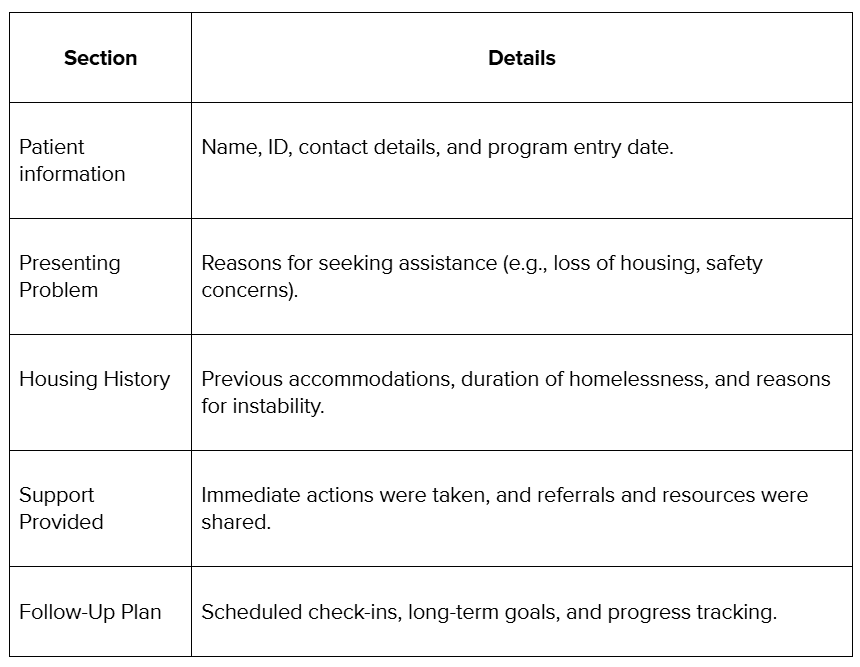
2. Medical & Palliative Care Case Note Template
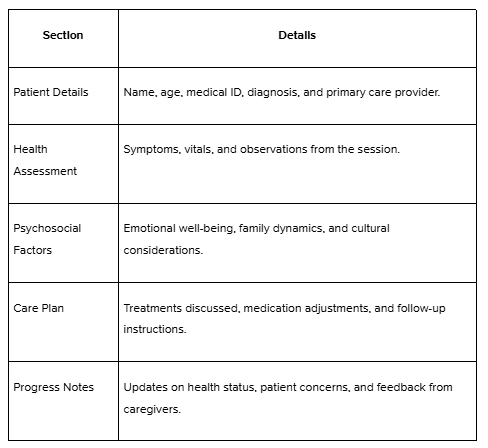
3. Mental Health Social Worker Case Note Template
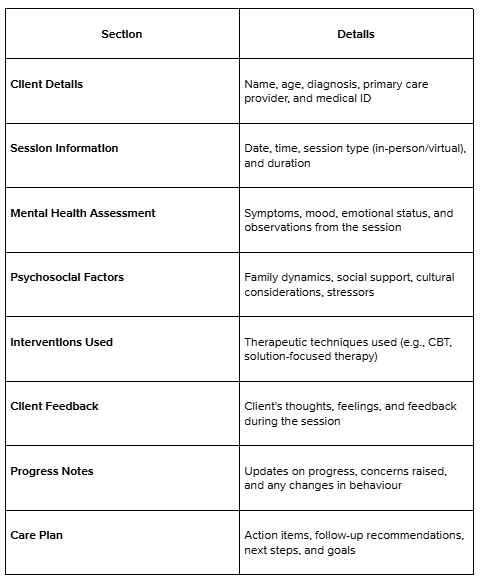
These templates give you a solid foundation while allowing adjustments based on your specific cases.
Using templates doesn’t limit your creativity; it ensures that every detail is captured clearly and effectively. When your notes are consistent and thorough, you’re setting yourself and your patients up for success.
With the proper templates in place, Let’s look at the most effective formats that turn detailed case notes into powerful professional tools.
Popular Case Note Formats
When documenting your work, the correct format can transform your notes from mundane to meaningful. Social workers use various styles to organise their case notes, and each one has its strengths. Let’s explore the most popular formats, compare them, and add a touch of real-life practicality to bring them to life.
1. Top Case Note Formats
Case note formats are structured frameworks that help you organise patient details efficiently. They ensure no critical information is missed, making it easier to track progress, communicate with colleagues, and stay aligned with professional standards. Here’s a closer look at the most commonly used ones:
- SOAP (Subjective, Objective, Assessment, Plan): Breaks notes into patient-reported information, observable facts, your professional analysis, and actionable steps.
Example: A patient shares feelings of anxiety during meetings (Subjective). You observe they fidget often (Objective). You determine that social anxiety may be affecting their work (Assessment). You plan weekly coaching sessions (Plan).
- BIRP (Behavior, Intervention, Response, Plan): Centers around what the patient does and how they respond to interventions.
Example: A patient frequently misses therapy sessions (Behavior). You discuss transportation challenges and suggest a carpool option (Intervention). The patient expressed relief and agreed to try it (Response). You schedule follow-ups to track attendance (Plan).
- DAP (Data, Assessment, Plan): Keeps it concise by focusing on the facts, your evaluation, and next steps.
Example: A young patient discloses difficulties at school (Data). You assess that peer bullying is a contributing factor (Assessment). You plan to involve a school counsellor (Plan).
- GIRP (Goal, Intervention, Response, Plan): This approach focuses on patient goals and ties every step back to what the patient wants to achieve.
Example: A patient wants to secure stable housing (Goal). You connect them with local rental assistance programs (Intervention). After reviewing housing options, they express optimism (Response). You plan to follow up on their application progress (Plan).
Comparing Case Note Formats
Here’s a side-by-side comparison to help you see how these formats work:
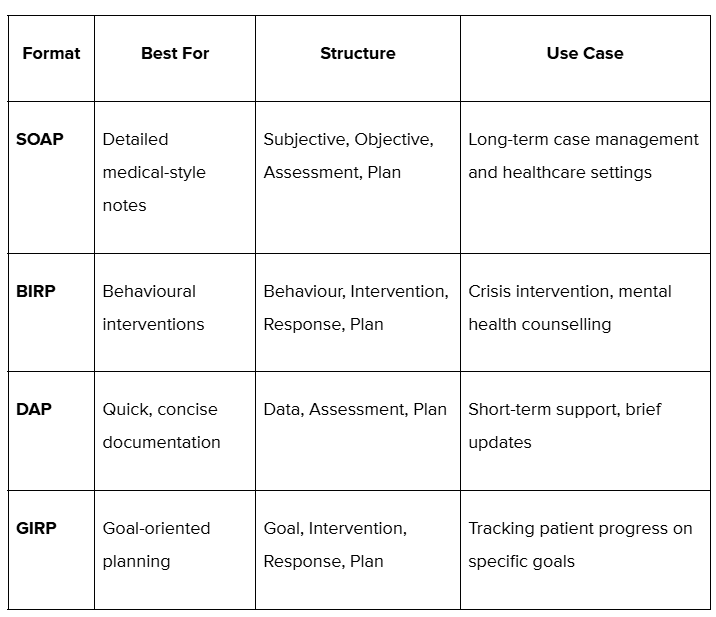
Which Note Format Fits Your Practice?
Selecting the correct format can make your work more effective—and save time. Let’s add some relatable examples to help you decide:
1. SOAP: Imagine you’re working with a patient recovering from substance use. SOAP lets you document your emotional reflections (e.g., triggers) and your concrete steps, like referrals for therapy or medication.
2. BIRP: If you’re dealing with a disruptive patient in school, BIRP helps you focus on how interventions (like positive reinforcement) impact their behaviour over time.
3. DAP: For quick follow-ups, like checking in with a family about applying for food assistance, DAP provides a straightforward way to record progress without overloading your notes.
4. GIRP: Are you working with a patient striving for financial independence? GIRP ensures that every action is tied to the patient's long-term goal, such as securing a stable job or effectively budgeting.
Let’s explore the key practices that ensure your social work case notes are accurate, professional, and precise every time.
Best Practices for Case Note Management
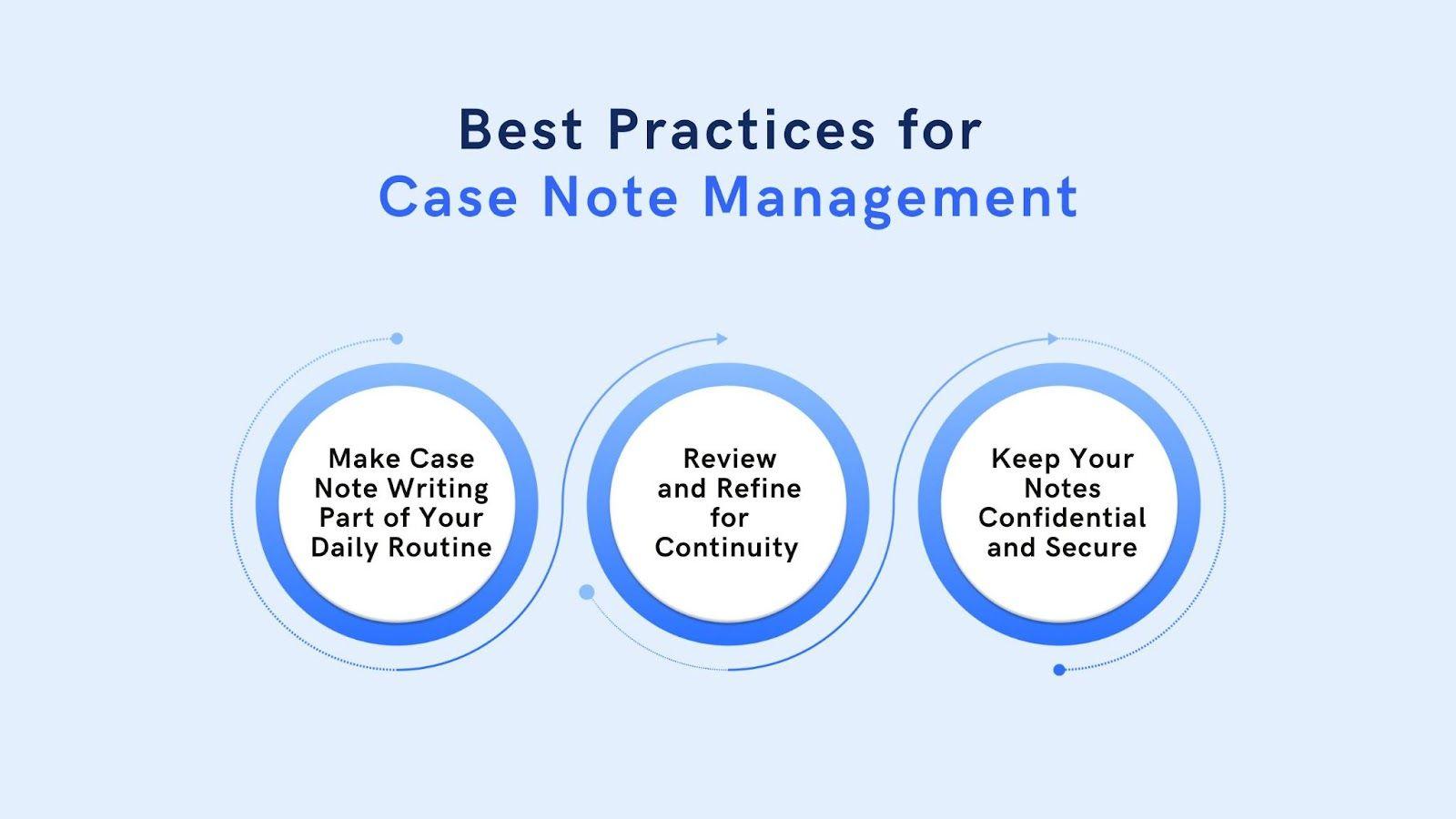
Keeping your case notes in check isn’t just about ticking boxes; it’s about ensuring you provide the best support for your patients while staying organised and professional. Let’s talk about how you can make case note management smoother, more efficient, and, most importantly, effective.
1. Make Case Note Writing Part of Your Daily Routine
Here’s the thing: if you wait too long to write your case notes, details will slip through the cracks. The best way to avoid this? Make it a habit. Dedicate a specific time each day, maybe right after your patient meetings, to jot down your notes while everything is fresh in your mind.
Example:You just finished a session with a patient struggling with housing instability. Instead of pushing it to later, take 10 minutes to write this:
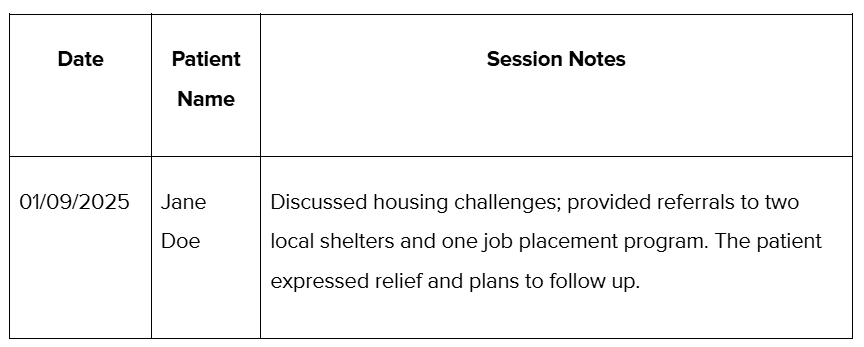
Building this into your routine will save time and keep your notes accurate.
2. Review and Refine for Continuity
Your notes shouldn’t just list what happened; they should also connect the dots over time. Take a moment every week to review your previous notes. This helps you stay consistent and follow up on critical issues.
Example: Imagine you’re working with a patient on managing stress, and last month, you documented their goal to establish a daily meditation practice. Reviewing your notes, you might add:

This continuity shows progress and ensures you build on what’s already been done.
3. Keep Your Notes Confidential and Secure
Protecting your patients’ information isn’t optional—it’s essential. Whether using digital tools or physical files, you must follow confidentiality regulations. Always store notes in secure, password-protected systems or locked cabinets.

Remember, confidentiality isn’t just about following rules—it’s about respecting your patients' trust in you. Let’s see how technology can simplify and enhance your case note management.
Using AI for Case Notes
Gone are the days of flipping through paper files and scrambling to find what you wrote last week. Technology has completely changed how social workers manage case notes. Whether you’re just starting with digital tools or looking to upgrade, let’s talk about how tech can make your life easier and your work even more effective.
1. Digital Tools and Case Management Software
Suppose you sit down at your desk and open your case management software, and in seconds, you have every detail about a patient at your fingertips. No digging through stacks of folders. No wasted time. Digital tools like case management software let you quickly organise, access, and update your notes.
For example, let’s say you’re working with a cloud-based tool like Practaluma. These platforms allow you to securely store patient information, track interactions, and set follow-up reminders.
Example Case Note in Software:
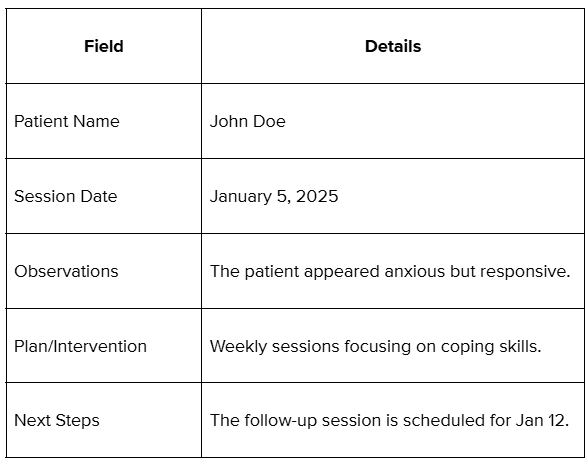
With everything in one place, your notes are well-organised and actionable.
2. Benefits of Secure, Cloud-Based Storage
When there is AI, there has to be data security and storage. You can’t afford to take risks with sensitive patient information. Secure, cloud-based servers give you peace of mind by protecting your data with encryption and backup systems.
For example, think about a scenario where your office experiences a flood with traditional paper records, which could be a disaster. But if you’re using a tool like Practaluma or Google Workspace (with HIPAA compliance) or a dedicated case management app, your notes are safe and can be accessed from anywhere.
Comparison of Storage Methods:
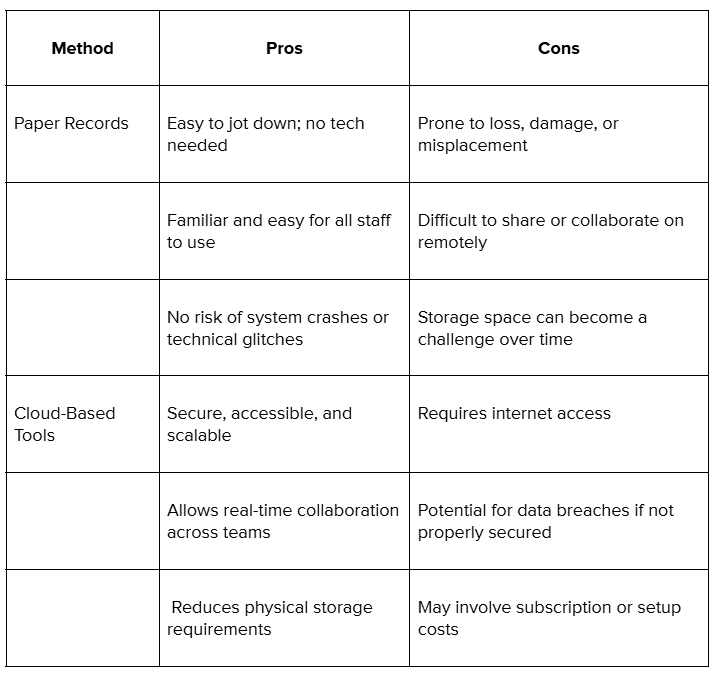
3. Adapting to Advancements in Note-Taking
If you’re still typing out notes manually in a Word document, it’s time to upgrade. Modern tools let you work smarter, not harder. Features like voice-to-text transcription can save you hours.
Let’s say you’ve just wrapped up a meeting with a patient. Instead of typing, you speak into your device:
“Session with Jane Doe on Jan 6. Discussed challenges with workplace stress. Recommended mindfulness exercises and set a check-in for next week.”
In seconds, your note is ready to review and save.
Voice-to-Text Template Example:
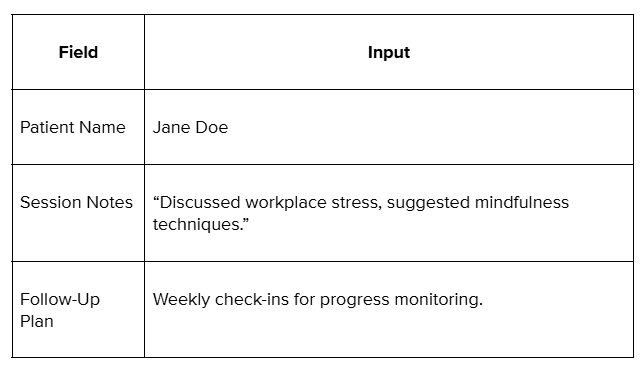
To learn more, check out this helpful YouTube video by Jasmine Ama, which provides additional insights on using technology to improve case note management.

Conclusion
Integrating technology into case note management has revolutionised how social workers and healthcare professionals handle their documentation. By leveraging digital tools, secure cloud-based solutions, and advanced note-taking features, you can enhance efficiency, ensure accuracy, and dedicate more time to patient care. Staying ahead with the right technology isn’t just a convenience—delivering high-quality services and maintaining professional standards is necessary.
For professionals seeking a seamless transition to efficient and secure case note management, Practaluma is an exceptional choice. With solutions designed specifically for healthcare and social work, Practaluma provides:
- User-Friendly Software: Simplify organising, accessing, and updating patient records.
- Secure Cloud Storage: Protect sensitive patient data with industry-leading encryption and compliance with regulatory standards.
- Customisable Features: Adapt tools to suit your workflow, ensuring productivity without compromising quality.
With Practaluma, you can work smarter, improve outcomes, and focus on what matters most—delivering exceptional care. Visit Practaluma today to explore their offerings and elevate your case note management.